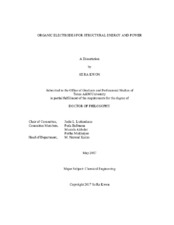| dc.description.abstract | Structural power systems, which simultaneously provide structural and electrochemical energy storage functionalities, have arisen as an emerging need for a wide range of applications. A challenge is to develop the multifunctional composite electrodes which can perform the acceptable energy storage and mechanical roles in a single platform. Composite electrodes containing graphene and polymers are designed using different processing techniques and examined in the context of multifunctional structural electrodes. The relationship between materials properties, processing methods, and performance of the composite electrodes is investigated.
Polyaniline nanofibers (PANI NF)/reduced graphene oxide (RGO) composite electrodes are fabricated using spray-assisted layer-by-layer (LbL) assembly. In this spray-on approach, the most critical parameters to create uniform electrodes are blow-drying time and removal of rinsing step. The architecture and electrochemical performance are investigated and compared against control electrodes made by dip-assisted LbL assembly. The spray-assisted PANI NF/RGO LbL electrodes exhibit over 70 times faster film growth behavior and a more porous structure than dip-assisted LbL electrodes. The increased porosity enables an enhanced rate capability and a higher power at a given specific energy compared to dip-assisted LbL electrodes.
To design multifunctional structural electrodes, mechanically strong aramid nanofibers (ANFs) are utilized as reinforcing building blocks and blended with graphene using different film fabrication techniques. RGO/ANF LbL films are fabricated using dip-assisted LbL assembly. The resulting electrodes exhibit an ANF-rich structure where ANFs act as a polymer matrix that interfacially interacts with RGO sheets. Chemical reduction leads to higher electrochemical performance. Nanomechanical testing shows that the electrodes have a modulus intermediate between the individual ANF and GO components. No cracks or defects are observed upon flexing 1000 times, which demonstrates that RGO/ANF LbL electrodes are promising for flexible, mechanically robust energy and power.
Free-standing RGO/ANF supercapacitor electrodes are fabricated via vacuum-assisted filtration and exhibit extraordinary mechanical strength and excellent electrochemical performance, which is attributed to the incorporation of ANFs as reinforcing nanofillers into the system where RGO sheets are interconnected with ANFs by non-covalent interfacial interactions. The RGO/ANF composite electrodes show multifunctionality superior to that of other graphene-based supercapacitors, indicating an excellent combination of both mechanical and electrochemical properties. | en |


